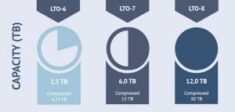Air-Gap: A Cybersecurity Benefit
ArchiveOf course, magnetic tape is an old technology but the simple reason of being old does not make it ineffective or impractical to use in the modern data center. Many would dare to say, magnetic tape is so retro its totally new again. I am inclined to believe that. Why? For one, the most modern data centers, called hyper-scalers, are leveraging the use of magnetic tape and cost-efficiency for such large magnitudes of data. For the rest of us, it mainly has to do with the cybersecurity benefit of air-gapping a backup copy.
I recently did a webinar where I teamed up with one of Quantum’s IT managers to discuss mainly what his IT organization did to protect against Ransomware. (If you missed, see here: Ransomware Webinar ). Maybe for some it felt like it was a pitch for tape coming from a company that owns more than 30% of the tape market, but the reality is that we have seen and heard from many companies how air-gapping a backup copy truly became the best last line of defense against the nemesis of Ransomware. Plus, if we didn’t use the solution ourselves, would you really buy it from us?
When your organization was saved multiple millions of dollars because you stored a backup copy of your asset or last week’s data on tape and saved the most precious intangible commodity of time, creativity and effort plus the tangible ones like new data of new customer acquisitions, market intelligence and new product analysis you too would also say, damn tape is freakin’ awesome. Ransomware, due to the patience and tenacity of the criminals behind it, can sit and pause for any length of time inspecting your network from a distance until they discover a way to bypass your security. This is not to say, that the cybersecurity software in the market today aren’t amazing solutions, but if we’ve learned something it is that cyber-criminals are tenaciously patient and very hungry to be rewarded. This is why, air-gap is the best last line of defense. Working together with cybersecurity software, SDDs, flash and replication technology as data moves from a hot to cold status, air-gapping becomes very cost-effective and the best way to store long-term data. In no way, are we saying replace your ultra-speeds that SSDs or flash offer in a back-up scenario, but rather include an air-gap backup copy on magnetic tape in the event you find your network connected devices compromised by ransomware. The enterprise backup environment is being hit hard by these vile characters and you don’t want to be caught by surprise.

 As cameras and other media devices steadily rise in number and improve in capability, sports broadcasters, production companies, and movie studios all face a mutually critical challenge: What to do with these expanding libraries of valuable content?
As cameras and other media devices steadily rise in number and improve in capability, sports broadcasters, production companies, and movie studios all face a mutually critical challenge: What to do with these expanding libraries of valuable content?